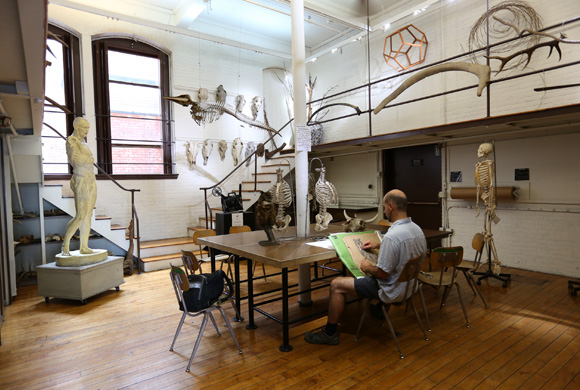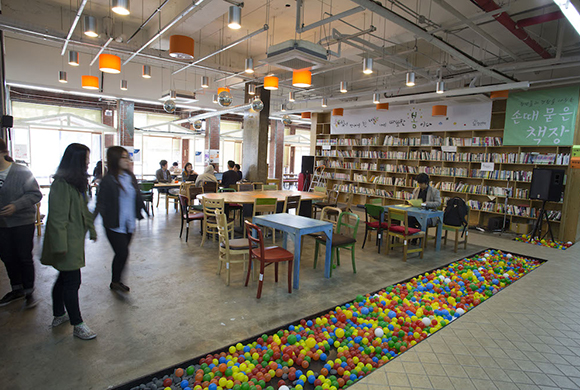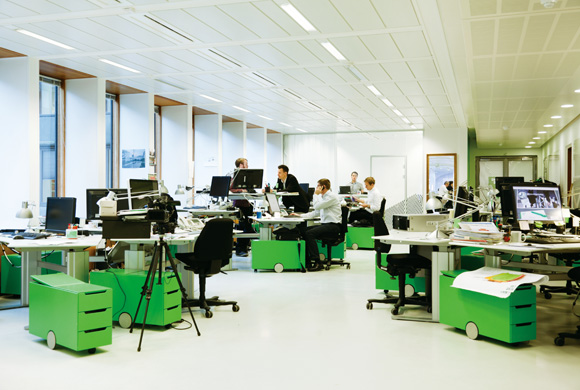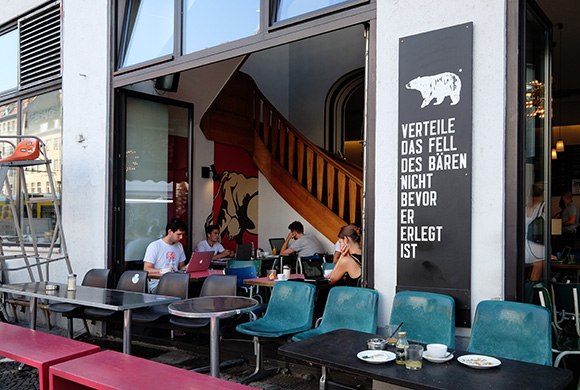Workplace
Feb. 3, 2014

Using the Attraction of Nature and the Sense of Analog in Design Education
The art college known as the leading college of art and design in the world
[Rhode Island School of Design (RISD)] Rhode Island, USA
The Rhode Island School of Design (RISD) is an art college founded in Providence, Rhode Island in 1877. This well-known school with a long history is well-regarded around the world. One famous graduate is fashion designer Nicole Miller.
In a vast campus with a magnificent harmony of town and buildings are the some 90 departments such as apparel, architecture and industrial design (including 16 graduate departments), where some 2,000 students are currently being educated. For this issue of WORKSIGHT, we visited the unique setting of the furniture design department.
“The fundamental philosophy of this department is that there is no disconnect between making and thinking,” says John Dunnigan, Department Head of RISD Furniture Design. The Department is divided into two areas, with a space known as the Home Space for classroom learning and meetings, a space for hands-on efforts called the Workshop. However, the Department also has its “laboratory,” which the graduate students are enrolled in.
There is no meaning in the categorization that, “this work must be done in this place,” but that in the school space there is no disconnect between “making” and “thinking.” This is the school’s philosophy, one that must also be reflected in the spaces.
“It’s important in doing our work that we have a fluid and consistent relationship between ‘making’ and ‘thinking.’ They sit and think, or go to the library, do research on their computers, make things in the Workshop or use the 3D printers,” Mr. Dunnigan says. “These are all part of the chain of events that occur in the laboratory that is RISD.” The philosophy earlier mentioned is also reflected here as well.
There are currently about 25 students in each class of the Department of Furniture Design, so the three years combined means a select group of about 75 students. For each class of 25, there are also 16 graduate students and two instructors who provide the lessons. The school is also structured so that the professors change positions each semester.
 Founded: 1877
Founded: 1877
Students: 2,386 (Autumn, 2012)
The RISD campus shares space with Ivy League member Brown University in Providence, Rhode Island, a city known as academic. There are no new buildings on the campus, but converted older ones.
http://www.risd.edu/
 John Dunnigan
John Dunnigan
Department Head of RISD Furniture Design
The Department also has a very traditional, hands-on making teaching style.
The design world has long had a trend towards the digital, and many other design schools only teach in the digital realm, with outside vendors actually doing and construction work. RISD, however, has not turned its back on making things by hand.
In the process of designing with the hands, students first investigate the concept theoretically, then actually create it with their own hands. Doing it in this way means studying more than how to communicate with other companies, but knowing much more about yourself.
This concept is also embodied in the curriculum. During their first year, students study based on drawing—designs and sketches—all based on using the hand. Digital drawing is introduced only in the second year, because the curriculum is always based on a progression from analog to digital skills.
The meaning behind the stress on the analog is fundamental in the Nature Lab. This was founded by Edna Lawrence in 1937, who taught drawing at RISD.
She believed in teaching drawing using a range of references, including taxidermied animals, human anatomical models, insects and other objects which she stored here. Although she passed away some time ago, her name lives on in this space within RISD, and she is well known to many students.
The technology which takes advantages of the shape or structure of an organism is known as bio-mimicry; while it has been widely noted lately, the Department of Furniture Design has been engaged in bio-mimicry from more than 80 years.
The Lab has advanced, high-tech equipment that you won’t normally find at an art school, such as microscopes. For example, a student might use the facilities to study the patterns of a butterfly wing for a textile to use on furniture, or perhaps use the construction that allows a beetle’s wings to open and shut in automobile design.
 Students draw, make models or hold meetings at their desks.
Students draw, make models or hold meetings at their desks.


 Tools, a range of machinery and materials are prepared in the Workshop so students can get right to work on models and prototypes.
Tools, a range of machinery and materials are prepared in the Workshop so students can get right to work on models and prototypes.
The Department of Furniture Design naturally places great efforts in the office furniture field. “This is an area that we’ve been involved in for about 100 years,” Mr. Dunnigan says, “and there are still new areas to take on.”
RISD is currently involved in many projects with corporations; one of these involve study into a reclining stool and a desk that allows people to stand while working.
When students first enter, many are interested in furniture, installations or textiles, but a task in the fourth year to design a chair over six weeks time helps to gradually increase interest in office furniture as well.
The Department of Furniture Design has seen many of its graduates go on to work with global furniture makers. “In the current semester, there are many students who are interested in home offices,” Mr. Dunnigan says. “This is another field we are paying attention to.”
There are many projects being conducted with corporations. this joint work give the students the opportunity to see the world outside the university, which provides many opportunities to learn by coming in contact with real business activities. In the projects with RISD staff and students, the corporations also say that they gain fresh ways of thinking.
“For the partner companies, the goal is not so much the design of a particular project, but the fresh way of thinking that helps them invigorate their organization,” Mr. Dunnigan says.
Without the restriction that the name “art college” can bring, a big step for RISD also came with the appointment in June of 2008 of Japanese-American John Maeda as President of the school.
“The President was formerly Assistant Manager of the MIT Media Lab, and he brought the sponsorship method to RISD,” Mr. Dunnigan explains. “This strengthens the ties with outside companies, and was also involved in student financial aid. Thanks to this, we were able to enroll more students who are qualified but were not able to afford the school. This was a very positive change for us.”
John Maeda is a graphic designer, professor and writer with a number of degrees in his possession. He is very actively promoting RISD around the world, and continues to speak out on the importance of art and design for RISD.
“I believe we are entering a new age of innovation in which artists and designers will be working together with engineers,” Mr. Dunnigan says. “This is not in traditional fields like painting or furniture, but artists and designers becoming active in fields such as government organizations or health care.” As RISD continues to transmit this new way of thinking in the future, it will also be even more active in many business areas.
Web-exclusive content
July 11th, 2013 the RISD campus Providence, Rhode Island, United States
 The campus, making use of an old building in Boston. Once a bank, the pillars and walls remain. Even the vault is there underground.
The campus, making use of an old building in Boston. Once a bank, the pillars and walls remain. Even the vault is there underground.

 Animals, plants, insects, nuts—a huge variety of specimens are stored here.
Animals, plants, insects, nuts—a huge variety of specimens are stored here.
John Maeda
Graphic designer, visual artist, computer scientist and more, Mr. Maeda carries many titles. Assistant manager of the MIT Media Lab’s Simplicity Consortium, he became president of RISD in June of 2008. His book The Laws of Simplicity describes a method for simplifying life, design and business. In 2008 he was named to Esquire magazine’s list of the 75 most influential people for the 21st century.











